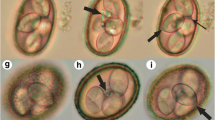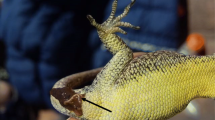Abstract
In this study, rodents (Rattus rattus) and mollusks (Achatina fulica) were captured in a small forest located in a large metropolitan city in Brazil, and they were examined to investigate possible parasitism by Angiostrongylus cantonensis. The parasites were recovered as helminths from the pulmonary arteries of the synanthropic rodents and as third-stage larvae (with Metastrongylidae family characteristics) from the mollusks. To confirm the species, these larvae were used to experimentally infect Rattus norvegicus for the posterior recovery of adult helminths. To identify the adult helminths, morphological, morphometric, molecular, and phylogenetic techniques were employed. Furthermore, we also characterized the histological lesions associated with parasitism in naturally infected definitive hosts. Our results demonstrated the occurrence of a natural life cycle of A. cantonensis (with the presence of adult helminths) in definitive hosts, Rattus rattus, and third-stage larvae in an intermediate host, A. fulica. In free-living rodents, lesions of granulomatous pneumonia in the lungs and meningitis in the brain were also found. These results warn of the risk of accidental transmission of A. cantonensis to human residents around the park because of the extensive interaction among the fauna of the park, domestic animals, and the surrounding human population.

Similar content being viewed by others
Data availability
All the data and material are owned by the authors and/or no permissions are required.
Change history
03 November 2022
A Correction to this paper has been published: https://doi.org/10.1007/s00436-022-07707-0
References
Albuquerque FS, Peso-Aguiar MC, Assunção-Albuquerque MJ (2008) Distribution, feeding behavior and control strategies of the exotic land snail Achatina fulica (Gastropoda: Pulmonata) in the northeast of Brazil. Braz J Biol 68(4):837–42. https://doi.org/10.1590/S1519-69842008000400020
Arruda JO, Santos L (2022) First record of Achatina fulica Bowdich, 1822 (Mollusca, Achatinidae), for the state of Rio Grande do Sul. Brazil Biotemas 35(1):1–6. https://doi.org/10.5007/2175-7925.2022.e85055
Barbosa TA, Thiengo SC, Fernandez MA, Graeff-Teixeira C, Morassutti AL, Mourão FRP, Miranda COS, Jorge MM, Costa LF, Gomes SR (2020) Infection by Angiostrongylus cantonensis in both humans and the snail Achatina (Lissachatina) fulica in the city of Macapá, in the Amazon Region of Brazil. Mem Inst Oswaldo Cruz 115:e200115. https://doi.org/10.1590/0074-02760200115
Barratt J, Chan D, Sandaradura I, Malik R, Spielman D, Lee R, Marriott D, Harkness J, Ellis J, Stark D (2016) Angiostrongylus cantonensis: a review of its distribution, molecular biology and clinical significance as a human pathogen. Parasitology 143(9):1087–1118. https://doi.org/10.1017/S0031182016000652
Bowles J, Blair D, McManus DP (1992) Genetic variants within the genus Echinococcus identified by mitochondrial DNA sequencing. Mol Biochem Parasitol 54(2):165–173. https://doi.org/10.1016/0166-6851(92)90109-w
Caldeira RL, Mendonca CLF, Gouveia CO, Lenzi HL, Graeff-Teixeira C, Lima WS, Mota EM, Pecora IL, Medeiros AM, Carvalho SO (2007) First record of molluscs naturally infected with Angiostrongylus cantonensis (Chen, 1935) (Nematoda: Metastrongylidae) in Brazil. Mem Inst Oswaldo Cruz 102(7):887–889. https://doi.org/10.1590/S0074-02762007000700018
Chen H-T (1935) A new pulmonary nematode of rats, Pulmonema cantonensis n. g., n. sp. from Canton. Ann Parasitol Hum Comp 13(4):312–317. https://doi.org/10.1051/parasite/1935134312
Cognato BB, Morassutti AL, Silva AC, Graeff-Teixeira C (2013) First report of Angiostrongylus cantonensis in Porto Alegre, State of Rio Grande do Sul, Southern Brazil. Rev Soc Bras Med Trop 46(5):664–665. https://doi.org/10.1590/0037-8682-0073-2013
Cunha MCR (2017) Meningiteeosinofílica: relato De Caso. RBAC 49(2):213–215
Eamsobhana P (2014) Eosinophilic meningitis caused by Angiostrongylus cantonensis – a neglected disease with escalating importance. Trop Biomed 31(4):569–578
Edgar RC (2004) MUSCLE: multiple sequence alignment with high accuracy and high throughput. Nucleic Acids Res 32(5):1792–1797. https://doi.org/10.1093/nar/gkh340
Espírito-Santo MCC, Pinto PLS, Mota DJG, Gryschek RCB (2013) The first case of Angiostrongylus cantonensis eosinophilic meningitis diagnosed in the city of São Paulo, Brazil. Rev Inst Med Trop Sao Paulo 55(2):129–132. https://doi.org/10.1590/s0036-46652013000200012
Kumar S, Stecher G, Tamura K (2016) MEGA7: Molecular Evolutionary Genetics Analysis Version 7.0 for Bigger Datasets. Mol Biol Evol, version 7.0 33(7):1870–1874. https://doi.org/10.1093/molbev/msw054
Lima ARMC, Mesquita SD, Santos SS, Aquino ERP, Rosa LRS, Duarte FS, Teixeira AO, Costa ZRS, Ferreira MLB (2009) Alicata disease: neuroinfestation by Angiostrongylus cantonensis in Recife, Pernambuco. Brazil Arq Neuropsiquiatr 67(4):1093–1096
Lv S, Zhang Y, Zhang L, Liu Q, Liu HX, Hu L, Wei FR, Steinmann P, Graeff-Teixeira C, Zhou XN, Utzinger J (2012) The complete mitochondrial genome of the rodent intra-arterial nematodes Angiostrongylus cantonensis and Angiostrongylus costaricensis. Parasitol Res 111(1):115–123. https://doi.org/10.1007/s00436-011-2807-4
Ma G, Dennis M, Rose K, Spratt D, Spielman D (2013) Tawny frogmouths and brushtail possums as sentinels for Angiostrongylus cantonensis, the rat lungworm. Vet Parasitol 192(1–3):158–165. https://doi.org/10.1016/j.vetpar.2012.11.009
Maldonado A, Simões RO, Oliveira APM, Motta EM, Fernandez MA, Pereira ZM, Monteiro SS, Torres EJL, Thiengo SC (2010) First report of Angiostrongylus cantonensis (Nematoda: Metastrongylidae) in Achatina fulica (Mollusca: Gastropoda) from Southeast and South Brazil. Mem Inst Oswaldo Cruz 105(7):938–941. https://doi.org/10.1590/s0074-02762010000700019
Mills JN (2006) Biodiversity loss and emerging infectious disease: an example from the rodent-borne hemorrhagic fevers. Biodiversity 7(1):9–17. https://doi.org/10.1080/14888386.2006.9712789
Morassutti AL, Thiengo SC, Fernandez M, Sawanyawisuth K, Graeff-Teixeira C (2014) Eosinophilic meningitis caused by Angiostrongylus cantonensis: an emergent disease in Brazil. Mem Inst Oswaldo Cruz 109(4):399–407. https://doi.org/10.1590/0074-0276140023
Moreira VLC, Giese EG, Melo FTV, Simões RO, Thiengo SC, Maldonado A, Santos JN (2013) Endemic angiostrongyliasis in the Brazilian Amazon: natural parasitism of Angiostrongylus cantonensis in Rattus rattus and R. norvegicus, and sympatric giant African land snails, Achatina fulica. Acta Trop 125(1):90–97. https://doi.org/10.1016/j.actatropica.2012.10.001
Ronquist F, Teslenko M, Van Der Mark P, Ayres DL, Darling A, Höhna S, Larget B, Liu L, Suchard MA, Huelsenbeck JP (2012) MrBayes 3.2: efficient Bayesian phylogenetic inference and model choice across a large model space. Syst Biol 61(3):539–542. https://doi.org/10.1093/sysbio/sys029
Simões RO, Monteiro FA, Sánchez E, Thiengo SC, Garcia JS, Costa-Neto SF, Luque JL, Maldonado A (2011) Endemic angiostrongyliasis, Rio de Janeiro, Brazil. Emerg Infect Dis. Rio de Janeiro, Brazil 17(7):1331–1333. https://doi.org/10.3201/eid1707.101822
Thiengo SC, Fernandez MA, Torres EJ, Coelho PM, Lanfredi RM (2008) First record of a nematode Metastrongyloidea (Aelurostrongylus abstrusus larvae) in Achatina (Lissachatina) fulica (Mollusca, Achatinidae) in Brazil. J Invertebr Pathol 98(1):34–39. https://doi.org/10.1016/j.jip.2007.10.010
Wang QP, Lai DH, Zhu XQ, Chen XG, Lun ZR (2008) Human angiostrongyliasis. Lancet Infect Dis 8(10):621–630. https://doi.org/10.1016/S1473-3099(08)70229-9
Acknowledgements
The authors would like to thank the Park Foundation of Prefeitura of Belo Horizonte, Minas Gerais.
Funding
This study received financial support from the Research Support Foundation of the State of Minas Gerais (Fundação de Amparo à Pesquisa do Estado de Minas Gerais, FAPEMIG), WSL grant numbers 18898 and 0242413. Fellowships were provided by the Conselho Nacional de Desenvolvimento Científico e Tecnológico, CNPq (WSL, grant number 480469/2012–1) and the Coordenação de aperfeiçoamento de Pessoal de Nível Superior – Brazil (CAPES) – Finance Code 001.
Author information
Authors and Affiliations
Contributions
All authors contributed to the study conception and design. Material preparation and samples collection were performed by Lara Ribeiro de Almeida and Jéssica de Souza Joaquim. Laboratory analysis was performed by Lara Ribeiro de Almeida, Jéssica de Souza Joaquim, Roselene Ecco, and Lucas Moreira Botelho. The first draft of the manuscript was written by Lara Ribeiro de Almeida, Roselene Ecco, Giliane de Souza Trindade, Adriano Pereira Paglia, Walter dos Santos Lima, Teofania Heloisa Dutra Amorim Vidigal, and Cíntia Aparecida de Jesus Pereira. All authors read and approved the final manuscript.
Corresponding author
Ethics declarations
Ethics approval and consent to participate
This study was approved by the Ethics Committee for Animal Research of the UFMG under protocol 306/2017 and by the Biodiversity Information and Authorization System (SISBIO) of the Instituto Chico Mendes de Conservação da Biodiversidade (ICMBio) under license 12989–2.
Competing interests
The authors declare no competing interests.
Additional information
Section Editor: Hiroshi Sato
Publisher's note
Springer Nature remains neutral with regard to jurisdictional claims in published maps and institutional affiliations.
The original online version of this article was revised: The authors regret that the current supplementary file for their article needs to be corrected. The original article has been corrected.
Supplementary Information
Below is the link to the electronic supplementary material.
Rights and permissions
Springer Nature or its licensor (e.g. a society or other partner) holds exclusive rights to this article under a publishing agreement with the author(s) or other rightsholder(s); author self-archiving of the accepted manuscript version of this article is solely governed by the terms of such publishing agreement and applicable law.
About this article
Cite this article
de Almeida, L.R., de Souza Joaquim, J., Botelho, L.M. et al. Parasitism in Rattus rattus and sympatric Achatina fulica by Angiostrongylus cantonensis in an urban park in southeast Brazil. Parasitol Res 122, 347–352 (2023). https://doi.org/10.1007/s00436-022-07656-8
Received:
Accepted:
Published:
Issue Date:
DOI: https://doi.org/10.1007/s00436-022-07656-8




